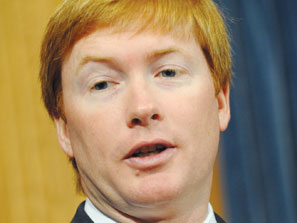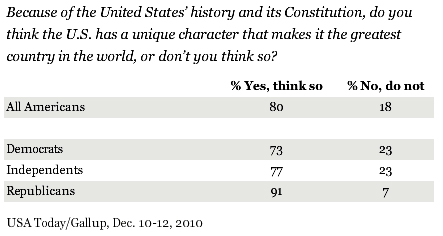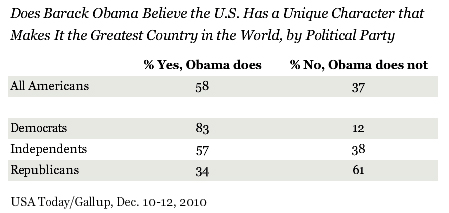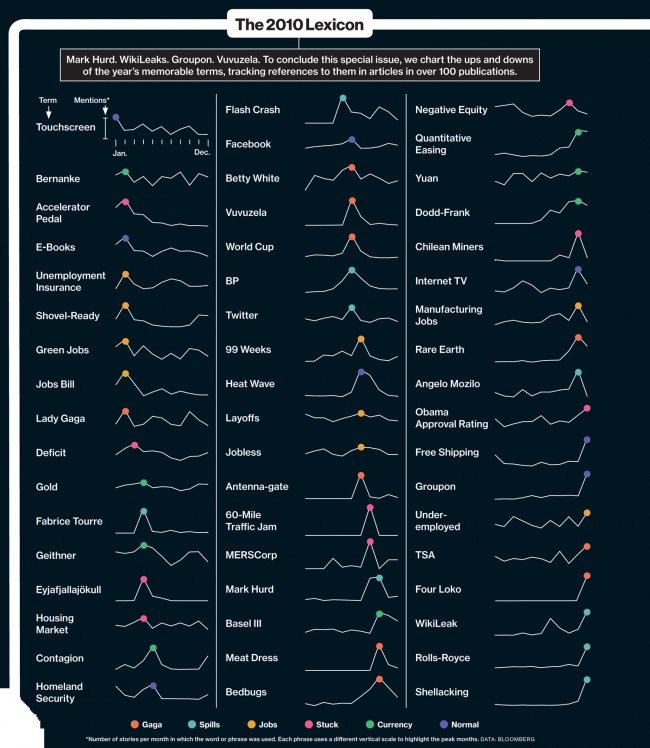
You’re welcome to send your Live Wire news tips or suggestions to [email protected].
Today’s Live Wire: Quick Links
- Florida Gains 2 More House Seats
- After All That A-Rated FCAT Hype
- Graph Your Own Census
- Ag Commissioner Adam Putnam’s Bosses
- Invading Pakistan? Worst Idea Yet
- Medicare’s Therapy Fraud Express
- The Smithsonian’s New Culture War
- Buzzwords of 2010
- Monday’s Moon Eclipse in Motion
- F. Scott Fitzgerald Reads John Keats
- Is America Exceptional?
- A Few Good Links
![]()
Live Wire Rewinds
![]()
Florida Gains 2 More US House Seats
 From the St. Pete Times: “A 17.6 percent population boom in the past decade will give Florida 27 House members beginning in 2012, boosting the state’s clout and ability to draw more federal funding. Florida now has as many seats as New York, a significant marker that shows how far the state has come since the advent of air conditioning. Already the biggest swing state in presidential elections, Florida stands to be even more influential. The population growth — up to 18.8 million from 15.9 million — will push Florida’s Electoral College votes to 29. […] Now comes the hard part: determining where the new seats will go, an often bitter political fight that may not be resolved until June 2012. The Republican-led Florida Legislature will decide where to put the seats, and there is early talk of Central Florida getting the attention because of its rapid growth. Tampa Bay and Southwest Florida also could be a consideration. Overall, the nation’s population April 1 was 308,745,538, up from 281.4 million a decade ago, or 9.7 percent. It was the slowest decade-long growth rate since the Great Depression.” The full story.
From the St. Pete Times: “A 17.6 percent population boom in the past decade will give Florida 27 House members beginning in 2012, boosting the state’s clout and ability to draw more federal funding. Florida now has as many seats as New York, a significant marker that shows how far the state has come since the advent of air conditioning. Already the biggest swing state in presidential elections, Florida stands to be even more influential. The population growth — up to 18.8 million from 15.9 million — will push Florida’s Electoral College votes to 29. […] Now comes the hard part: determining where the new seats will go, an often bitter political fight that may not be resolved until June 2012. The Republican-led Florida Legislature will decide where to put the seats, and there is early talk of Central Florida getting the attention because of its rapid growth. Tampa Bay and Southwest Florida also could be a consideration. Overall, the nation’s population April 1 was 308,745,538, up from 281.4 million a decade ago, or 9.7 percent. It was the slowest decade-long growth rate since the Great Depression.” The full story.
See Also:
- Fact Check: How Forbes Got Palm Coast’s “Fastest-Growing City” Distinction Wrong
- Palm Coast’s Population Drops to 69,000 in Latest Census Estimate, Flagler’s to 85,600
- Election Primer: Amendments 5 and 6 Pit Power Against Voters in Redistricting
After All That A-Rated FCAT Hype
 Most schools and most school districts got A’s and B’s in the last FCAT go-around. It was statistically impossible, given their previous records. And it showed the FCAT losing its credibility as a true measuring stick of anything other than hyped-up self-esteem. A Miami Herald Editorial makes the point: “After the hype this month when a record number of Florida’s public high schools received an A or B grade from the state, the reality has set in: Next year’s measuring stick will have to be tougher. That’s as it should be to measure true learning gains and not allow grade inflation. That’s also the challenge facing Florida now that it’s getting Race to the Top federal funds to devise a plan to gauge teachers’ performance and pay them their worth based on students’ learning gains and other as-yet-undetermined factors. For the 2009-10 school year, the state graded high schools partly on the opportunities they offered their students to excel, but not as stringently on how those students performed in tougher courses made available to them. That can’t happen again. Students’ performance on accelerated courses like Advanced Placement should play a greater role in the state’s grading formula to accurately reflect gains made by each high school. […] The FCAT results now account for 50 percent of a school’s grade with graduation rates and participation and — to a lesser extent — performance on AP and other advanced courses also factored in. No surprise, then, that the number of A and B high schools soared statewide to 71 percent this year. […] Scoring big doesn’t mean anyone intentionally “gamed” the system. But the gains made this year statewide were so spectacular that they won’t be sustainable in the future. […] But key indicators still show Florida students are behind their peers nationally. While the achievement gap among white, black and Hispanic students has narrowed, it’s still large, and the 2009 results from the National Assessment of Educational Progress show Florida high school seniors performed below the national average for reading and math. […] The goal should be to continue to elevate expectations for students, who will rise to the occasion if given the tools to succeed. That means ensuring an accurate measure of students’ achievements at all levels — whether it’s on a standardized test or an AP course — and to use those scores to help all students live up to their potential.”
Most schools and most school districts got A’s and B’s in the last FCAT go-around. It was statistically impossible, given their previous records. And it showed the FCAT losing its credibility as a true measuring stick of anything other than hyped-up self-esteem. A Miami Herald Editorial makes the point: “After the hype this month when a record number of Florida’s public high schools received an A or B grade from the state, the reality has set in: Next year’s measuring stick will have to be tougher. That’s as it should be to measure true learning gains and not allow grade inflation. That’s also the challenge facing Florida now that it’s getting Race to the Top federal funds to devise a plan to gauge teachers’ performance and pay them their worth based on students’ learning gains and other as-yet-undetermined factors. For the 2009-10 school year, the state graded high schools partly on the opportunities they offered their students to excel, but not as stringently on how those students performed in tougher courses made available to them. That can’t happen again. Students’ performance on accelerated courses like Advanced Placement should play a greater role in the state’s grading formula to accurately reflect gains made by each high school. […] The FCAT results now account for 50 percent of a school’s grade with graduation rates and participation and — to a lesser extent — performance on AP and other advanced courses also factored in. No surprise, then, that the number of A and B high schools soared statewide to 71 percent this year. […] Scoring big doesn’t mean anyone intentionally “gamed” the system. But the gains made this year statewide were so spectacular that they won’t be sustainable in the future. […] But key indicators still show Florida students are behind their peers nationally. While the achievement gap among white, black and Hispanic students has narrowed, it’s still large, and the 2009 results from the National Assessment of Educational Progress show Florida high school seniors performed below the national average for reading and math. […] The goal should be to continue to elevate expectations for students, who will rise to the occasion if given the tools to succeed. That means ensuring an accurate measure of students’ achievements at all levels — whether it’s on a standardized test or an AP course — and to use those scores to help all students live up to their potential.”
See Also:
- FPC Improves from D to B, Matanzas High School Maintains a B, Heritage is an F
- Flagler District Scores an A for 3rd Year in a Row as 3 Schools Maintain A, 3 Drop Back
- Florida’s High School Students Near Bottom in College Readiness; Flagler’s Do Worse
IFRAMES not supported
Ag Commissioner Adam Putnam’s Bosses
 Adam Putnam, the cherub-looking Polk County native, wants to be president. There’s no mystery about that. He plans to run for governor in four years. He’s already put in his stint at the Florida Legislature and in Congress, on his way to his first statewide office as agriculture commissioner, the post he won this November. He’s all business–literally: his principal constituencies are business and reactionary conservatives. And he’s showing again who he answers to. From ThinkProgress: “Throughout 2010, the State Board of Education has considered banning sugary drinks from Florida schools, including soft drinks, high-sugar juices, and chocolate milk. According to the Orlando Sentinel, Board member John Padget “has been pressing his colleagues for a year to cut out most beverages besides water, pure juice and white, low-fat milk.” Justifying such a move, Padget writes in a Key West Citizen op-ed, is the fact that “over one-third of America’s children are either overweight or obese,” leaving them “often less ready to learn in the classroom.” A few weeks before the issue was to be considered, the state’s newly-elected Agriculture Commissioner, Adam Putnam, wrote a letter demanding that the Board of Education halt such a move. Putnam criticized the Board for choosing “to focus only on the nutrition content in beverages served in Florida schools,” rather than taking a more holistic approach:
Adam Putnam, the cherub-looking Polk County native, wants to be president. There’s no mystery about that. He plans to run for governor in four years. He’s already put in his stint at the Florida Legislature and in Congress, on his way to his first statewide office as agriculture commissioner, the post he won this November. He’s all business–literally: his principal constituencies are business and reactionary conservatives. And he’s showing again who he answers to. From ThinkProgress: “Throughout 2010, the State Board of Education has considered banning sugary drinks from Florida schools, including soft drinks, high-sugar juices, and chocolate milk. According to the Orlando Sentinel, Board member John Padget “has been pressing his colleagues for a year to cut out most beverages besides water, pure juice and white, low-fat milk.” Justifying such a move, Padget writes in a Key West Citizen op-ed, is the fact that “over one-third of America’s children are either overweight or obese,” leaving them “often less ready to learn in the classroom.” A few weeks before the issue was to be considered, the state’s newly-elected Agriculture Commissioner, Adam Putnam, wrote a letter demanding that the Board of Education halt such a move. Putnam criticized the Board for choosing “to focus only on the nutrition content in beverages served in Florida schools,” rather than taking a more holistic approach:
One such area that I look forward to tackling is ensuring that Florida’s students have better nutrition options to reduce obesity and related long-term health risks. This is a topic your Board has discussed recently for possible policy recommendations. However, instead of looking at the entire nutrition intake of students, you have chosen to focus only on the nutrition content in beverages served in Florida schools. It is my belief that any nutrition improvement plan needs to be certain that students are receiving the best possible nutrition package, in concert with total wellness initiatives, to allow them to reach their optimum achievement potential.
[…]
A ThinkProgress investigation has found that the incoming Agriculture Commissioner has been the benefactor of a significant amount of money from both the sugar and dairy lobby during the campaign – both of whom have a strong financial interest in keeping sugary drinks in schools. Despite Florida’s $500 contribution limit for both individuals and PACs, Putnam received at least $61,000 in campaign funds from sugar and dairy interests, including maxed-out contributions from Coca Cola’s lobbyist in Tallahassee Brian Ballard and a slew of maxed out contributions from the Sugar Barons of South Florida, the Fanjul family. Following his victory on November 2, Putnam also made a wealthy sugar magnate one of his first appointments.” The full post.
See Also:
- Swelled by Supermajority, Florida GOP Signals First Assault Victim: Medicaid
- State’s Small-Government Plan to Scale Back Food Inspections at Child Cares Backfires
Invading Pakistan? The Worst Idea Yet

Robert Dreyfuss in The Nation: “Two good reporters for the New York Times, Mark Maqzzetti and Dexter Filkins, write today that the United States is preparing for send troops across the border into Pakistan in pursuit of the Taliban, Al Qaeda, and any other bad guys they can find. If there’s a worse idea, I don’t know what it is. But it’s at least consistent with Barack Obama’s 2008 campaign statements that he’d carry the war across the border to get Osama bin Laden, remarks that drew horrified opposition from Obama’s election rival, John McCain, the noted dove. The idea, reported by the Times, isn’t policy yet. Thankfully. Like President Nixon’s decision to expand the war in Vietnam into Cambodia in pursuit of alleged Viet Cong “sanctuaries”—a decision that hugely destabilized Cambodia and led to millions of deaths—a policy of attacking Pakistan would destabilize that country, too, and serve only to push the sanctuaries deeper into Pakistan. The Times report is already getting pushback and denials all around, but that doesn’t mean it isn’t true. At the very least, the Times report signifies that the military or the White House is seriously considering the proposal. Following last week’s ersatz review of Afghanistan policy, after which the White House apparently concluded that everything is fine over there except for the fact that the insurgents have bases in Pakistan, it’s not surprising that hawks in the Obama administration are pushing to expand the war.” The full post.
See Also:
- Pakistan Against the United States
- 3,338 Days: U.S. Occupation of Afghanistan Is Now Longer Than Soviet Union’s
- Offshoring War: How Obama—and Those Moments of Silence—Insult Military Sacrifice
Medicare’s Therapy Fraud Express
From the Wall Street Journal: “Physical therapy, which cost Medicare almost $3.5 billion in 2008, offers a case study in how Medicare polices its payments. Even when Medicare identified providers whose physical-therapy billing raised red flags, it kept paying thousands or even millions of dollars, sometimes for years, The Wall Street Journal found. Among the cases:
•A physical therapist in Brooklyn who billed for so much therapy—more than $2.5 million in 2008 alone—that it would have been virtually impossible for him to have performed it all within state and Medicare guidelines, fraud experts say. Medicare has continued to pay him, shelling out nearly a million dollars through July of this year.
•A second doctor in Florida who pocketed more than $1.8 million from Medicare in 2007, much of it from physical therapy on patients with an extremely rare condition. Even after a Medicare antifraud contractor flagged this doctor, the agency paid him at least $6.7 million over more than two years.
•A Houston doctor whose Medicare billing under her provider number spiked from zero to more than $11.6 million in less than a year. At the time, this doctor was being investigated for misconduct in a company owned by a Nigerian with an alleged history of fraud.
There are plenty of reasons why Medicare often fails to stop questionable payments up front. To protect law-abiding doctors and hospitals—the vast majority—Medicare is required to pay nearly everybody within 30 days. Medicare says it is reluctant to suspend payments to providers who may have made honest mistakes, out of concern that beneficiaries might go without needed treatment. Law-enforcement agencies and Medicare contractors, overwhelmed by the sheer volume of Medicare fraud cases, can’t investigate and prosecute them all. Sometimes, prosecutors and investigators ask Medicare to keep paying so as not to tip off targets of an investigation. But a central problem is that Medicare hasn’t fully exploited its most valuable resource: its claims database, a computerized record of every claim submitted and every dollar paid out.” The full story.

See Also:
The Smithsonian’s New Culture War

From the New York Review’s blog: “On November 29, a conservative website posted an 11-second clip of ants crawling over a crucifix from a 4-minute video made by David Wojnarowicz, an artist who died of AIDS in 1992. The video, Fire in My Belly, was part of a show at the National Portrait Gallery called “Hide/Seek,” said to be the country’s first national exhibition devoted to gay and lesbian themes. Wojnarowicz made the video in 1986 and 1987, as his lover Peter Hujar was dying of AIDS, and as David himself learned that he was HIV-positive; it is an eerie meditation on life, death, violence, and nature, featuring imagery from the Day of the Dead. David later explained that he saw Jesus as a symbol of someone who willingly took on the suffering of the world. A self-appointed conservative guardian of public morality, William Donohue of the Catholic League, saw it differently, and attacked the video clip as blasphemous and demanded that Congress reconsider future funding of the Smithsonian in reprisal. The Smithsonian—which runs the National Portrait Gallery and which is funded by the US Government—promptly removed the video from the exhibition, effectively granting Donohue a “heckler’s veto.” […] But while the recent censorship of Wojnarowicz’s work recalls what happened in the early 1990s, the differences are also instructive. When the Corcoran closed the Mapplethorpe show and the NEA revoked Karen Finley’s funding, widespread public outcry followed. The Smithsonian’s decision to remove Wojnarowicz’s video, by contrast, has attracted comparatively little attention. We have come to expect timidity in public arts institutions. In some sense, the surprise is not that the Smithsonian removed the video, but that it put on “Hide/Seek” in the first place.
The muted public response to the current controversy points in two different directions. On the one hand, homosexual self-expression is substantially more accepted today than it was twenty years ago. David would, I think, be surprised and gratified by the changes wrought in American culture. Those changes have come about largely because David and others like him have been willing to speak out from the margins of our society, even as they found themselves hated by people they did not know simply because they were brave enough to express their sexual identities. On the other hand, the fundamentalist censorial strain remains a profound force in American society, reflected today in the populist and often intolerant undertones of the religious right and the Tea Party. And one thing has remained a disappointing constant—public institutions’ willingness to cave on issues of public controversy. Like so many other wars, the culture wars of the 1980s have left their traces on America’s character.” The full post.
From BusinessWeek, the year’s most “memorable” terms (click on the chart for larger view):
Monday’s Moon Eclipse in Motion
Here’s one view:
And here’s another through the lenses at Florida State:
See Also:
F. Scott Fitzgerald Reads John Keats
Dec. 21 marked the 70th anniversary of F. Scott Fitzgerald’s death from a heart attack. From the Reader’s Almanac: “In 1940 F. Scott Fitzgerald was in his fourth year working as a screenwriter in Hollywood, although with fewer assignments and less pay. He hoped the novel he was working on, The Love of the Last Tycoon, would revive his literary reputation. Few people were still reading him. His August 1940 royalty statement from Scribner’s reported sales of forty copies of his works (including seven copies of The Great Gatsby and nine of Tender Is the Night) for a total payment of $13.13. The writer he introduced to his editor Maxwell Perkins in 1925 was the current rage. Ernest Hemingway’s latest novel, For Whom the Bell Tolls, would sell more than 270,000 copies in its first year. […] As biographer Matthew Bruccoli recounts in Some Sort of Epic Grandeur, Fitzgerald suffered a dizzy spell following the premiere of a new film he and [gossip columnist Sheilah] Graham attended on December 20. Because his physician was coming to see him the next afternoon, Fitzgerald chose not to see a doctor. Reading about the German-Italian pact in the newspapers the next morning, Fitzgerald told Graham that he’d like to cover the war from Europe after he had completed his novel. “Ernest won’t have that field all to himself, then.” Moments later he started from his chair, clutched the mantelpiece and fell to the floor. Graham called the fire department. Fitzgerald was pronounced dead at 5:15 p.m. of coronary occlusion. He had completed the first draft of five of the projected nine chapters of his new novel. He was forty-four years old.” See the full post.
And below is Fitzgerald reading Keats. Open Culture reports: “According to Park Bucker, an associate professor of English at the University of South Carolina, the recording was likely made around 1940, during Fitzgerald’s last year, perhaps in a self-recording phonograph booth in Southern California. When Fitzgerald died, he was living in Los Angeles, a washed-up Hollywood screenwriter, hoping to write one last great novel. In her Paris Review interview, Dorothy Parker described Fitzgerald’s bleak last days: “It was terrible about Scott; if you’d seen him you’d have been sick. When he died no one went to the funeral, not a single soul came, or even sent a flower. I said, ‘Poor son of a bitch,’ a quote right out of The Great Gatsby, and everyone thought it was another wisecrack. But it was said in dead seriousness.”
See Also:
- Harold Bloom Recites Wallace Stevens’ “Tea at the Palace of Hoon”
- Pablo Neruda: Now You’re Mine
- Henry David Thoreau: The Journals
From Gallup: “Americans widely agree that the United States has a unique character because of its history and Constitution that sets it apart from other nations as the greatest in the world. This view, commonly referred to as “U.S. exceptionalism,” is shared by at least 73% of Americans in all party groups, including 91% of Republicans. At the same time that Americans believe the U.S. is exceptional, they also are inclined to believe that status is far from secure, according to the Dec. 10-12 USA Today/Gallup poll. Three-quarters of those who believe the U.S. is exceptional (62% of all Americans) also believe the U.S. is currently at risk of losing its unique character.”

And now for the refracted bigotry of unexceptional Americans: “Americans who identify as Republicans, likely reflecting the opinions of some of their party’s leaders, are especially dubious that Obama regards the U.S. as exceptional. Thirty-four percent of Republicans believe the president thinks the United States is the greatest country in the world, while 61% believe he does not. Democrats are much more confident that Obama regards the United States as exceptional, while the majority of independents agree.

See Also:
- What Haley Barbour’s amnesia tells us
- The Holocaust We Don’t See: Lanzmann’s Shoah Revisited
- Concert, recorded music sales crashed in 2010
- What if I’m Dealing with a Bully Boss?






























Leave a Reply